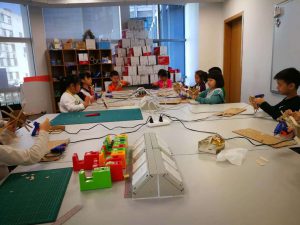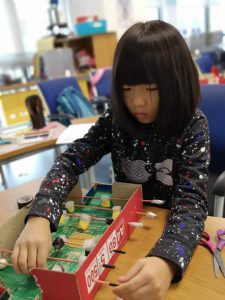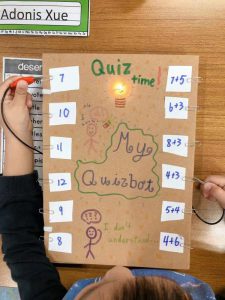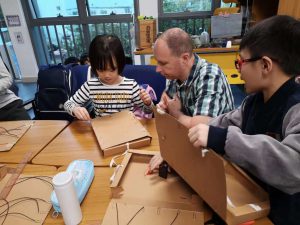Engineering is a project-based class that gives the teacher multiple opportunities to create and explore with the students. Three of the projects my students have constructed this year were the zoetrope (a kind of wheel used to animate pictures), a foosball game (tabletop soccer), and an electronic quiz game (in which when the correct answer matched the question a light comes on). Each of these projects is designed to be a representation of an unusual application of a common engineering principle or machine.
- The zoetrope is an example of a wheel and axle.
- The foosball project is an example of a cam.
- The quiz game is an example of electrical circuits and cross wiring.
I try to follow a pattern of construction/reinforcement through my projects, where in one project we are learning how to use tools and follow the correct format, and in the next we reinforce those skills we learned in the first construction project.
The Zoetrope
BISZ Engineering Video Zoetrope

For example, the zoetrope project was an example of a construction project. The project took seven or eight weeks to make, and included instruction on how to use all the tools required (hand drills, hot glue guns, etc.). Each step of the project was made by the students, even the compasses to measure the circles. However, the project was laid out for the students in a step-by-step format, and they were mostly required to follow the instructions and practice their skills using the tools.
The Foosball Game

The foosball project was a reinforcement project. The students were presented with a final, completed model. Then they were asked to look at the final project and reverse engineer the model. All of the skills necessary to complete the project had been covered in previous classes. To accompany the project, each student had a booklet that asked them to explain the steps and indicate if something went wrong, and how they would fix their mistakes next time. The students were encouraged to fill this in while working on the project rather than waiting until the end.
The Quiz Bot

The electronics game is another example of a construction project. We have looked at how circuits work, as well as the use of tools like wire strippers and pliers. There are elements of deconstruction as well, as students are often asked to troubleshoot problems by testing individual parts of the circuit to work out where the problems lie (battery pack, wiring, light globe, etc.).
At the end of the school year, the students’ final project will be to design and build their own building that contains a circuit, reinforcing all the circuitry skills they’ve learned.
The End Result

I have really enjoyed teaching engineering this year. As a teacher who prefers experiential learning, I’ve found it fascinating to watch the students go from constantly asking me what to do next, to implementing their own ideas for parts of a project–and finally moving to creating their own projects from scratch. It has been interesting to see how the students adapt to a more creative subject in a culture that is used to more linear lessons. The critical thinking and creative problem solving skills they learn in elementary engineering raise their ability to master higher concepts as they progress through their education.
Brett Cannon is an Elementary Engineering teacher at BASIS International School Shenzhen
There is clearly a bundle to realize about this. I suppose you made some good points in features also. dedadfkcdfbe
I really like your writing style, excellent info, thank you for putting up fddeffeakfkbekbf